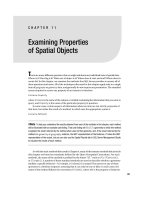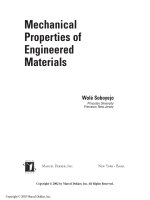Properties of minerals
Bạn đang xem bản rút gọn của tài liệu. Xem và tải ngay bản đầy đủ của tài liệu tại đây (1.3 MB, 28 trang )
Properties of Minerals
What is a
mineral?
The Rules of the Mineral
Every Mineral must
follow these set of rules
1. Naturally Occurring
2. Inorganic
3. Solid
4. Crystal Structure
5. Definite Chemical
Composition
Mineral Questions
1. Are pearls considered minerals?
• No, because they are made from
animals.
2. Is naturally occurring glass considered
to be a mineral?
• No, because it does not have a crystal
structure.
Crystal Structure
A
crystal is a solid in which the atoms
are arranged in a pattern that repeats
again and again.
Internal Arrangement of the Atoms
A tetrahedral site lies in the center of a 4-
A tetrahedral site lies in the center of a
4-
Definite Chemical
Composition
This
means that a mineral always
contains certain elements in definite
proportions
Quartz- always has one atom of Silica
for every two atoms of oxygen
The Mineral Beryl
Emerald
Aquamarine
The Mineral Corundum
Ruby
Sapphire
Birthstones
January - Garnet July - Ruby
February - Amethyst August - Peridot
March -AquamarineSeptemberSapphire
April – Diamond
October - Opal
May – Emerald
November - Topaz
June - Pearl
December - Zircon
Identifying Minerals
Each Mineral has its own specific
properties that can be used to identify it.
1. Hardness
2. Color
3. Streak
4. Luster
5. Density
6. Crystal Shape
7. Cleavage &
Fracture
8. Special
Properties
.
Mohs Hardness Scale
1
= Softest (talc or graphite)
10 = Hardest (diamond)
How do you determine if one mineral is
harder than the other?
Perform a scratch test.
If the mineral gets scratched it is softer
than the object that scratched it.
Which mineral is gold?
How would you be able to
tell the difference?
Streak- the color of a mineral
when it is made into a powder
Pyrite(fool’s gold) is
very similar in color to
real gold, but Pyrite
has a greenish-black
streak and gold has a
gold streak.
Luster- describes how light
reflects off a minerals surface
Metallic
Luster- describes minerals that
are shiny.
Glassy Luster- describes minerals that
look like they have a glassy surface, ex.
Quartz
*Minerals are usually described as
having a metallic or non-metallic luster.
Which mineral has a metallic
luster and which has a glassy
luster?
Crystal Shape
Every crystal has a characteristic shape that is due
to its Crystal structure.
Halite(NaCl or Salt)- will always have six sides
and form a cube
Hoppered pink Halite crystals from the evaporation
Minerals will either break by
cleavage or fracture?
Cleavage-
a minerals ability to split
easily along flat surfaces
Fracture-
minerals which break with
rough or uneven surfaces
Special Properties
Fluorescence-
some minerals glow under
ultraviolet light ex.) Fluorite
Magnetism- some metallic minerals are
naturally magnetic ex.) Magnetite
Effervescence- some minerals such as
Calcite fizz when acid is placed on it
Electrical Properties- a few minerals,
such as quartz produce an electrical current
Fluorite
Scheelite(fluorescent mineral)









